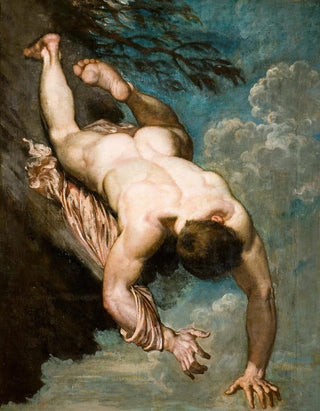Art print | Manlius leaping from the rock - William Etty


View from behind

Frame (optional)
In the world of art, some works transcend their era to become timeless witnesses of human passions. "Manlius thrown from the rock" by William Etty fits into this tradition, capturing with striking intensity the drama and tragedy of a mythological story. This painting, which evokes a struggle between honor and betrayal, immerses us in a universe where emotions are palpable, where each brushstroke seems to vibrate with its own life. The scene depicts a moment of extreme tension, inviting the viewer to question the very nature of justice and sacrifice. Contemplating this piece, one cannot help but feel the weight of human choices, the consequences that follow, and the tragic beauty that results.
Style and uniqueness of the work
Etty's style is distinguished by his ability to blend realism with romantic sensitivity. In "Manlius thrown from the rock," the mastery of color and light is particularly striking. Warm tones and deep shadows create an atmosphere that is both dramatic and emotional. The bodies of the characters, sculpted with almost academic precision, reveal an in-depth knowledge of human anatomy, while being imbued with an expressiveness that transcends mere visual rendering. The composition, centered on the protagonist, draws the eye and guides the viewer through the scene, emphasizing the clash between the hero and his tragic fate. This blend of technique and passion makes this work a masterpiece that continues to inspire and amaze, both through its aesthetic and its message.
The artist and his influence
William Etty, born in 1787, is often regarded as one of the pioneers of Romantic painting in England. His career, marked by an incessant quest for artistic expression, leads him to explore various themes, ranging from mythology to scenes of everyday life. Etty stands out for his boldness in tackling often taboo subjects, notably nudity and sensuality, which earns him both admiration and controversy. His influence is felt not only in his time, but

Matte finish

View from behind

Frame (optional)
In the world of art, some works transcend their era to become timeless witnesses of human passions. "Manlius thrown from the rock" by William Etty fits into this tradition, capturing with striking intensity the drama and tragedy of a mythological story. This painting, which evokes a struggle between honor and betrayal, immerses us in a universe where emotions are palpable, where each brushstroke seems to vibrate with its own life. The scene depicts a moment of extreme tension, inviting the viewer to question the very nature of justice and sacrifice. Contemplating this piece, one cannot help but feel the weight of human choices, the consequences that follow, and the tragic beauty that results.
Style and uniqueness of the work
Etty's style is distinguished by his ability to blend realism with romantic sensitivity. In "Manlius thrown from the rock," the mastery of color and light is particularly striking. Warm tones and deep shadows create an atmosphere that is both dramatic and emotional. The bodies of the characters, sculpted with almost academic precision, reveal an in-depth knowledge of human anatomy, while being imbued with an expressiveness that transcends mere visual rendering. The composition, centered on the protagonist, draws the eye and guides the viewer through the scene, emphasizing the clash between the hero and his tragic fate. This blend of technique and passion makes this work a masterpiece that continues to inspire and amaze, both through its aesthetic and its message.
The artist and his influence
William Etty, born in 1787, is often regarded as one of the pioneers of Romantic painting in England. His career, marked by an incessant quest for artistic expression, leads him to explore various themes, ranging from mythology to scenes of everyday life. Etty stands out for his boldness in tackling often taboo subjects, notably nudity and sensuality, which earns him both admiration and controversy. His influence is felt not only in his time, but






